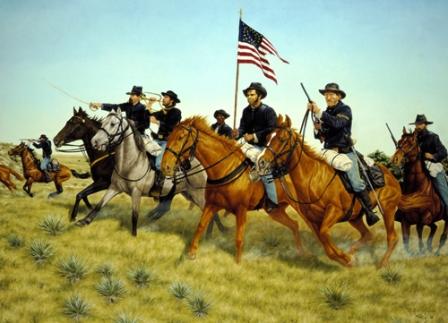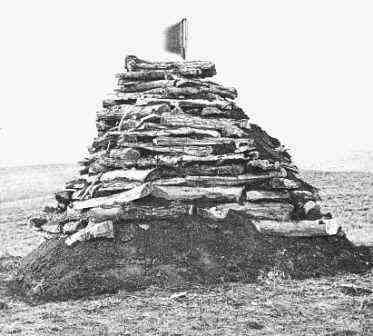Specific Causes of the Battle of Bighorn
What were the specific causes of the Battle of Bighorn? The specific causes of the Battle of Bighorn at a local level were: Facts about the Battle of Bighorn
The History of the Battle of Bighorn including details of the cause, reason, and summary. The dates and years of the Battle of Little Bighorn - when and why the battle started and the consequences of the conflict. Who fought in the Battle of Bighorn? The combatants of the Battle of Bighorn were the US Cavalry and Sioux, Cheyenne & Arapaho Indians. When did the conflict start and when did the conflict end? What were the causes, what was the significance, what were the results and effects? Interesting history and facts about this historic conflict in the fast facts sheet. | Fast Facts about the Battle of Bighorn | | Name of Conflict: | | Battle of Little Bighorn
| | | Alternative Names: | | Battle of Big Horn, Custer's Last Stand, Battle of Greasy Grass, Battle of Bighorn
| | | Location: | | Little Bighorn River in Montana
| | | Name of War: | | The Battle of Little Bighorn was a major conflict in Great Sioux War, aka the Black Hills War, of 1876 to 1877
| | | Date of Battle: | | June 25 1876
| | | Duration of the Battle: | | Less than 1 hour
| | | Combatants: | | United States 7th Cavalry fought against Sioux, Cheyenne and Arapaho warriors, tribes of the Northern Plains
| | | Strength of Forces: | | 700 men fighting for the US against approximately 1500 Native Indians
| | | Result of the Battle of Little Bighorn: | | The conflict ended in defeat for the US and the deaths of George Custer and the 7th Cavalry - nearly 200 troops
| | | Famous Leaders: | | Sitting Bull, Crazy Horse, Rain in the Face and Chief Gall
George Armstrong Custer, Marcus Reno, Frederick Benteen, James Calhoun | |
The following pictures are of the leaders of the conflict
Chief Sitting Bull and General George Armstrong Custer. History & Causes of the Battle of Bighorn - Political Policies and Beliefs
What were the causes of the Battle of Bighorn? Some of the history and causes of the Indian Wars and battles were dictated by general policies & beliefs which shaped the historical background to the causes of the Battle of Little Bighorn. Culture Clash: Distrust and hostilities grew between the indigenous population of the region and the Europeans as the number of newcomers increased leading to the inevitable culture clash. A major cause of conflict in the 1800's Land: The United States adopted the European practice of expansion and of recognizing only limited land rights of indigenous peoples. A major cause of conflict in the 1700 and 1800's Manifest Destiny: In the 1800's advocates of 'Manifest Destiny' fuelled by religious fervour believed in American cultural and racial superiority and efforts to "civilize" the indigenous people was widespread. A major cause of conflict in the 1800's Extermination of the buffalo: The US government promoted a policy to exterminate the buffalo in the 1870'S which would inevitably mean the demise of the Indians who relied on them for almost every aspect of their existence. This, in turn, would reduce the capacity of the Native Indians to continue armed battles against the United States
The Battle of Bighorn Map
The location of the Battle of Bighorn is indicated on the map which illustrates the US three pronged movements headed by Gibbon, Terry and Custer and General George Crook during the Great Sioux War. 
Battle of Little Bighorn Map The Significance and Effects of the Battle of Bighorn
The effects and significance of the Battle of Bighorn in history is that the Battle of the Little Bighorn was the beginning of the end of the Indian Wars. The nomadic hunter lifestyle of the Plains Indians was lost forever. The languages, culture, religion, beliefs and ceremonies of conquered people fell into decline. The news in the East of the disastrous defeat at the Battle of Little Bighorn shocked people who were accustomed to battlefield victories and convinced of their inherent superiority and claim to manifest destiny. The US Government expanded the Army in the region by 2,500 men following the Defeat at the Battle of Little Bighorn. The Battle of Little Bighorn led to increased intolerance of the Native Indians and a determination to place them on a reservation in order to 'civilise' them. 
Battle of Bighorn - The Little Bighorn Battlefield National Monument
The Little Bighorn Battlefield National Monument (formerly Custer Battlefield National Monument) preserves the site of the Battle of the Little Bighorn. The graves of those killed in the Little Bighorn Battle are located around a granite monument marking the spot of 'Custer's last stand. The first memorial on the site was assembled by Captain George K. Sanderson and the 11th Infantry who buried the mutilated bodies where they were found. In 1877 the body of George Custer, who had been buried at Little Bighorn, was re-interred in West Point Cemetery. 
Photo of the Custer Hill Monument at the site of the Battle of Little Bighorn History Timeline of the Battle of Little Bighorn
This short History Timeline of the Battle of Bighorn provides fast facts and information about the history, years & dates, key events and famous people who fought in the Battle of Bighorn.
| History Timeline of the Battle of Little Bighorn |
| 1874 | George Custer led an expedition to the Black Hills of Dakota and reported that he had discovered gold
| |
| 1875 | The US government attempt to buy the Black Hills of Dakota from the Indians | |
| 1875 | The offer is refused as the land includes the sacred burial grounds of the Sioux | |
| 1876 | 8 February: War Department orders operations against hostile Indians | |
| 1876 | 17 March: Colonel Reynolds attacks Cheyenne on Powder River | |
| 1876 | 24 March: Survivors of Powder River seek refuge with Crazy Horse | |
| 1876 | April: The Black Hills gold rush leads to the establishment of the mining town of Deadwood
| |
| 1876 | 16 May: Lieutenant James Bradley discovers Lakota Sioux and Cheyenne camp on Tongue River
| |
| 1876 | April: The Black Hills gold rush leads to the establishment of the mining town of Deadwood
| |
| 1876 | 5 June: Sitting Bull creates the Sun Dance alliance, named after this famous ritual, between the Lakota Sioux and the Cheyenne. During the event Sitting Bull has a vision of "soldiers falling into his camp like grasshoppers from the sky." and prophesizes a great victory
| |
| 1876 | June 17: The Battle of the Rosebud between the United States Army led by General George Crook and a force of Lakota Sioux. The Battle of the Rosebud delayed Crook from joining Custer and the 7th Cavalry at the Battle of Little Bighorn
| |
| 1876 | June 22: General Alfred H. Terry and George Custer are ordered to pursue the Indians. They plan to trap the Indians between their two forces
| |
| 1876 | June 25: Custer abandons the plan when he locates a large group of Sioux, Cheyenne and Arapaho Indians and devises a three-pronged attack from different locations, led by himself, Captain Frederick Benteen and Major Marcus Reno assuming that the Indians would attempt to escape, rather than to fight
| |
| 1876 | June 26: Major Marcus Reno attacks first, is overwhelmed by the unexpected number of Indians and retreats
| |
| 1876 | Major Reno is joined by the fresh troops of Captain Benteen | |
| 1876 | 26 June: The Battle of the Little Bighorn begins. The major force of Indians ride to attack General Custer killing all of his 231 men who included Custer, his two brothers, Tom and Boston, his brother-in-law, James Calhoun, and his nephew, Autie Reed. The infamous conflict became known as the Battle of Little Bighorn.
| |
| 1876 | 27 June: General Alfred H. Terry and Montana Column (450 men) arrive to discover Custer's dead battalion at the scene of the Battle of Little Bighorn. The dead bodies had been stripped of their clothing and ritually mutilated. Reno and Benteen are rescued (they lost 47 men in their fights)
| |
| 1876 | 27 June: Captain George K. Sanderson and the 11th Infantry bury the mutilated bodies where they were found on the site of the Battle of Little Bighorn
| |
| 1876 | July: The stunned and angry reaction to the US defeat at the Battle of Little Bighorn prompted a massive outcry and the US government flooded the area with troops, forcing the Indians to surrender or flee.
| |
| 1877 | July: The body of George Custer, who had been buried at the site of the Battle of Little Bighorn, was re-interred in West Point Cemetery.
| | | History Timeline of the Battle of Bighorn |
Battle of Bighorn- Significance, causes, summary, dates and history of the Battle of Bighorn for kids
- History timeline of the Battle of Bighorn
- Interesting Facts and information on the Battle of Bighorn for kids and schools
- Cause and Effects of the Battle of Bighorn
- Significance, causes events, summary, dates and history of the Battle of Bighorn for kids
Battle of Little Bighorn - Pictures and Videos of Native Americans
Battle of Bighorn. Discover the key years, famous people and events of the Battle of Bighorn together with the causes and effects of the war, conflict and battle. Pictures have been include wherever possible which show the battlefield, clothing and weapons of the Native Indian tribes and their leaders who fought in the Battle of Bighorn. The Battle of Bighorn. The videos enable fast access to the information and the many facts featured on this subject of the Battle of Bighorn. |